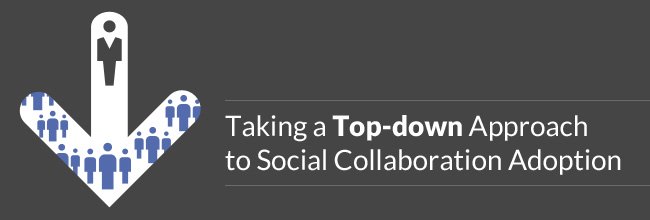Taking a Top-down Approach to Social Collaboration Adoption
Implementing a social collaboration tool can be quite a feat – but it is only half the battle. In order for it to be successful, it must also be adopted into your organization. Depending upon your organization’s culture, a top-down approach in which your executives lead the charge could help with social collaboration adoption.
In a top-down adoption model, it’s important to get executive support and participation early on, as well as throughout the project.
Step One: Get Buy-in
Work with your executive team early on to get buy-in for your social collaboration project. Sell them on the benefits of social collaboration, as well as the value their department will see with active participation. This may include an increase in productivity, employee engagement, and top-line revenue, as well as better innovation and a decrease in training costs.
By first explaining how a social collaboration tool can help them at a high level, you can open up discussion on how they could use it on a day-to-day basis. For instance, many managers may be interested to see how knowledge sharing on a social tool can help improve productivity. Their team members are currently asking questions via email and waiting for an answer, and many are asking the exact same questions. On the other side, the same employees are answering those questions over and over again. Instead, each question and answer could be recorded in your social tool so that they’re accessible anytime, anywhere, to anyone in your organization.
When executives are bought in to the benefits, they will be more interested in using the tool themselves, and will encourage their teams to use it.
Step Two: Get Them to Use It
Even before the social collaboration project launches, work with each executive to determine ways they can use the tool to reach their department’s objectives. Find ways for it to integrate with their current tools and workflows, so it’s easy to use and so that it adds value. Then train your executives on how to best use the tool and how to roll it out to their teams.
Once you’ve implemented the tool, regularly check in on usage and follow up with executives as needed. Are they using the tool as discussed? Are they experiencing any roadblocks to adoption?
Getting your executives up and running on your new social collaboration tool as quickly as possible will help you achieve company-wide adoption.
Step 3: Get them to Encourage Others to Use It
Once your executives are actively using the tool, they can encourage others to do the same. The content they’ve already seeded will give other users a reason to visit the tool, and something to engage with.
They should also encourage others to create their own content. For instance, when someone asks a question, the executive should encourage that person to first search for an answer on the tool. If an answer can’t be found, they should ask the question within the tool so that the entire team has the opportunity to answer or learn the answer.
Finally, executives can encourage others to use the tool by engaging with a variety of content themselves. Something as simple as a “thumbs up” could suffice, although they could also chime in with a comment or an answer of their own. As employees see executives using the tool, they will learn that it’s not only ok to ask for help when it’s needed, but also that it’s encouraged.
Social collaboration adoption rarely happens on it’s own, but rather requires a critical mass before widespread adoption occurs. By showing executives the value of social collaboration and getting them involved early on, they will champion the tool, begin to build the critical mass, and influence their teams to get on board.


